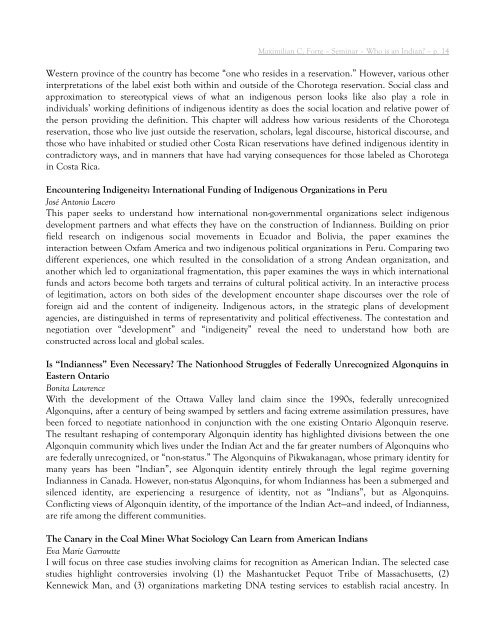Who Is An Indian: Race, Blood, DNA, and the Politics of Indigeneity in the Americas
by Dr. Maximilian C. Forte
by Dr. Maximilian C. Forte
Create successful ePaper yourself
Turn your PDF publications into a flip-book with our unique Google optimized e-Paper software.
Maximilian C. Forte – Sem<strong>in</strong>ar – <strong>Who</strong> is an <strong>Indian</strong>? – p. 14<br />
Western prov<strong>in</strong>ce <strong>of</strong> <strong>the</strong> country has become “one who resides <strong>in</strong> a reservation.” However, various o<strong>the</strong>r<br />
<strong>in</strong>terpretations <strong>of</strong> <strong>the</strong> label exist both with<strong>in</strong> <strong>and</strong> outside <strong>of</strong> <strong>the</strong> Chorotega reservation. Social class <strong>and</strong><br />
approximation to stereotypical views <strong>of</strong> what an <strong>in</strong>digenous person looks like also play a role <strong>in</strong><br />
<strong>in</strong>dividuals’ work<strong>in</strong>g def<strong>in</strong>itions <strong>of</strong> <strong>in</strong>digenous identity as does <strong>the</strong> social location <strong>and</strong> relative power <strong>of</strong><br />
<strong>the</strong> person provid<strong>in</strong>g <strong>the</strong> def<strong>in</strong>ition. This chapter will address how various residents <strong>of</strong> <strong>the</strong> Chorotega<br />
reservation, those who live just outside <strong>the</strong> reservation, scholars, legal discourse, historical discourse, <strong>and</strong><br />
those who have <strong>in</strong>habited or studied o<strong>the</strong>r Costa Rican reservations have def<strong>in</strong>ed <strong>in</strong>digenous identity <strong>in</strong><br />
contradictory ways, <strong>and</strong> <strong>in</strong> manners that have had vary<strong>in</strong>g consequences for those labeled as Chorotega<br />
<strong>in</strong> Costa Rica.<br />
Encounter<strong>in</strong>g <strong>Indigeneity</strong>: International Fund<strong>in</strong>g <strong>of</strong> Indigenous Organizations <strong>in</strong> Peru<br />
José <strong>An</strong>tonio Lucero<br />
This paper seeks to underst<strong>and</strong> how <strong>in</strong>ternational non-governmental organizations select <strong>in</strong>digenous<br />
development partners <strong>and</strong> what effects <strong>the</strong>y have on <strong>the</strong> construction <strong>of</strong> <strong>Indian</strong>ness. Build<strong>in</strong>g on prior<br />
field research on <strong>in</strong>digenous social movements <strong>in</strong> Ecuador <strong>and</strong> Bolivia, <strong>the</strong> paper exam<strong>in</strong>es <strong>the</strong><br />
<strong>in</strong>teraction between Oxfam America <strong>and</strong> two <strong>in</strong>digenous political organizations <strong>in</strong> Peru. Compar<strong>in</strong>g two<br />
different experiences, one which resulted <strong>in</strong> <strong>the</strong> consolidation <strong>of</strong> a strong <strong>An</strong>dean organization, <strong>and</strong><br />
ano<strong>the</strong>r which led to organizational fragmentation, this paper exam<strong>in</strong>es <strong>the</strong> ways <strong>in</strong> which <strong>in</strong>ternational<br />
funds <strong>and</strong> actors become both targets <strong>and</strong> terra<strong>in</strong>s <strong>of</strong> cultural political activity. In an <strong>in</strong>teractive process<br />
<strong>of</strong> legitimation, actors on both sides <strong>of</strong> <strong>the</strong> development encounter shape discourses over <strong>the</strong> role <strong>of</strong><br />
foreign aid <strong>and</strong> <strong>the</strong> content <strong>of</strong> <strong>in</strong>digeneity. Indigenous actors, <strong>in</strong> <strong>the</strong> strategic plans <strong>of</strong> development<br />
agencies, are dist<strong>in</strong>guished <strong>in</strong> terms <strong>of</strong> representativity <strong>and</strong> political effectiveness. The contestation <strong>and</strong><br />
negotiation over “development” <strong>and</strong> “<strong>in</strong>digeneity” reveal <strong>the</strong> need to underst<strong>and</strong> how both are<br />
constructed across local <strong>and</strong> global scales.<br />
<strong>Is</strong> “<strong>Indian</strong>ness” Even Necessary? The Nationhood Struggles <strong>of</strong> Federally Unrecognized Algonqu<strong>in</strong>s <strong>in</strong><br />
Eastern Ontario<br />
Bonita Lawrence<br />
With <strong>the</strong> development <strong>of</strong> <strong>the</strong> Ottawa Valley l<strong>and</strong> claim s<strong>in</strong>ce <strong>the</strong> 1990s, federally unrecognized<br />
Algonqu<strong>in</strong>s, after a century <strong>of</strong> be<strong>in</strong>g swamped by settlers <strong>and</strong> fac<strong>in</strong>g extreme assimilation pressures, have<br />
been forced to negotiate nationhood <strong>in</strong> conjunction with <strong>the</strong> one exist<strong>in</strong>g Ontario Algonqu<strong>in</strong> reserve.<br />
The resultant reshap<strong>in</strong>g <strong>of</strong> contemporary Algonqu<strong>in</strong> identity has highlighted divisions between <strong>the</strong> one<br />
Algonqu<strong>in</strong> community which lives under <strong>the</strong> <strong>Indian</strong> Act <strong>and</strong> <strong>the</strong> far greater numbers <strong>of</strong> Algonqu<strong>in</strong>s who<br />
are federally unrecognized, or “non-status.” The Algonqu<strong>in</strong>s <strong>of</strong> Pikwakanagan, whose primary identity for<br />
many years has been “<strong>Indian</strong>”, see Algonqu<strong>in</strong> identity entirely through <strong>the</strong> legal regime govern<strong>in</strong>g<br />
<strong>Indian</strong>ness <strong>in</strong> Canada. However, non-status Algonqu<strong>in</strong>s, for whom <strong>Indian</strong>ness has been a submerged <strong>and</strong><br />
silenced identity, are experienc<strong>in</strong>g a resurgence <strong>of</strong> identity, not as “<strong>Indian</strong>s”, but as Algonqu<strong>in</strong>s.<br />
Conflict<strong>in</strong>g views <strong>of</strong> Algonqu<strong>in</strong> identity, <strong>of</strong> <strong>the</strong> importance <strong>of</strong> <strong>the</strong> <strong>Indian</strong> Act—<strong>and</strong> <strong>in</strong>deed, <strong>of</strong> <strong>Indian</strong>ness,<br />
are rife among <strong>the</strong> different communities.<br />
The Canary <strong>in</strong> <strong>the</strong> Coal M<strong>in</strong>e: What Sociology Can Learn from American <strong>Indian</strong>s<br />
Eva Marie Garroutte<br />
I will focus on three case studies <strong>in</strong>volv<strong>in</strong>g claims for recognition as American <strong>Indian</strong>. The selected case<br />
studies highlight controversies <strong>in</strong>volv<strong>in</strong>g (1) <strong>the</strong> Mashantucket Pequot Tribe <strong>of</strong> Massachusetts, (2)<br />
Kennewick Man, <strong>and</strong> (3) organizations market<strong>in</strong>g <strong>DNA</strong> test<strong>in</strong>g services to establish racial ancestry. In


















